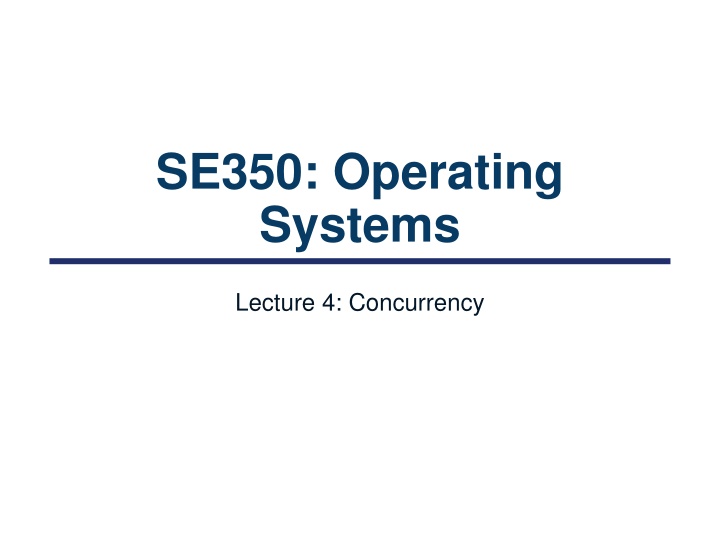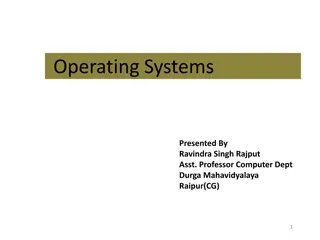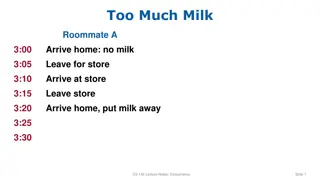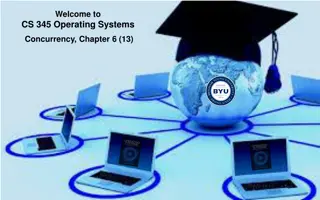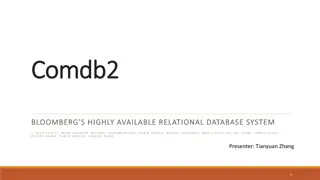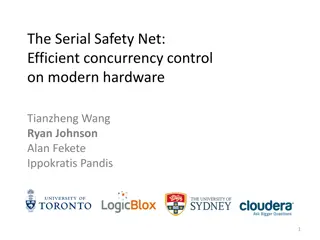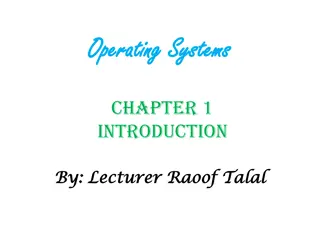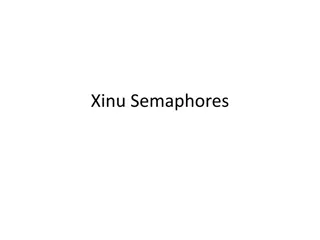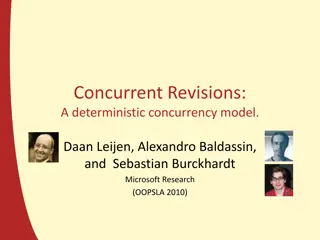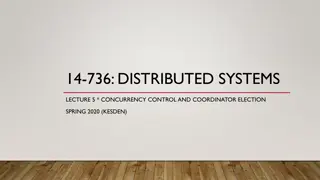Concurrency in Operating Systems
This lecture covers the concept of concurrency in operating systems, focusing on multi-threaded processes, thread data structure, life cycle, simple thread API, and thread implementation. It delves into traditional UNIX processes, process control blocks (PCB), time-sharing, and multiplexing processes to provide an understanding of how operating systems manage and prioritize processes efficiently.
Download Presentation

Please find below an Image/Link to download the presentation.
The content on the website is provided AS IS for your information and personal use only. It may not be sold, licensed, or shared on other websites without obtaining consent from the author.If you encounter any issues during the download, it is possible that the publisher has removed the file from their server.
You are allowed to download the files provided on this website for personal or commercial use, subject to the condition that they are used lawfully. All files are the property of their respective owners.
The content on the website is provided AS IS for your information and personal use only. It may not be sold, licensed, or shared on other websites without obtaining consent from the author.
E N D
Presentation Transcript
SE350: Operating Systems Lecture 4: Concurrency
Feedback https://forms.gle/L6oS18zZApNF3ERb8 Will be available until the end of term Will be checked regularly
Outline Multi-threaded processes Thread data structure and life cycle Simple thread API Thread implementation
Recall: Traditional UNIX Process Process is OS abstraction of what is needed to run single program Often called heavyweight process Processes have two parts Sequential program execution stream (active part) Code executed as sequential stream of execution (i.e., thread) Includes state of CPU registers Protected resources (passive part) Main memory state (contents of Address Space) I/O state (i.e. file descriptors)
Process Control Block (PCB) (Assume single threaded processes for now) OS represents each process as process control block (PCB) Status (running, ready, blocked, ) Registers, SP, (when not running) Process ID (PID), user, executable, priority, Execution time, Memory space, translation tables,
Recall: Time Sharing vCPU1 vCPU2 vCPU3 vCPU1 vCPU2 vCPU3 vCPU1 vCPU2 Shared Memory Time How can we give illusion of multiple processors with single processor? Multiplex in time! Each virtual CPU needs structure to hold PCBs PC, SP, and rest of registers (integer, floating point, ) How do we switch from one vCPU to next? Save PC, SP, and registers in current PCB Load PC, SP, and registers from new PCB What triggers switch? Timer, voluntary yield, I/O,
How Do We Multiplex Processes? Current state of process is held in PCB This is snapshot of execution and protection environment Only one PCB active at a time (for single-CPU machines) OS decides which process uses CPU time (scheduling) Only one process is running at a time Scheduler gives more time to important processes OS divides resources between processes (protection) This provides controlled access to non-CPU resources Example mechanisms: Memory translation: give each process their own address space Kernel/User duality: arbitrary multiplexing of I/O through system calls
Scheduling Kernel scheduler decides which processes/threads receive CPU There are lots of different scheduling policies providing Fairness or Realtime guarantees or Latency optimization or Kernel Scheduler maintains data structure containing PCBs if (readyProcesses(PCBs)) { nextPCB = selectProcess(PCBs); run(nextPCB); } else { run_idle_process(); }
Context Switch: CPU Switch Between Two Processes Code executed in kernel is overhead Overhead sets minimum practical switching time Less overhead with SMT/hyperthreading, but contention for resources
Lifecycle of Processes As process is executed, its state changes New: Process is being created Ready: Process is waiting to run Running: Instructions are being executed Waiting: Process waiting for some event to occur Terminated: Process has finished execution
Ready Queue PCBs move from queue to queue as they change state Decisions about which order to remove from queues are scheduling decisions Many algorithms possible (more on this in a few weeks)
Ready Queue And I/O Device Queues Process not running PCB is in some scheduler queue Separate queue for each device/signal/condition Each queue can have different scheduler policy Ready Queue Head Tail Link Link Link Registers Registers Registers Other State PCB9 Other State PCB6 Other State PCB16 Head Tail USB Unit 0 Disk Unit 0 Head Tail Link Link Registers Registers Other State PCB2 Other State PCB3 Disk Unit 2 Head Tail Link Ether Netwk 0 Head Tail Registers Other State PCB8
Drawback of Traditional UNIX Process Silly example: main() { ComputePI( pi.txt ); PrintClassList( class.txt ); } Would program ever print out class list? No! ComputePI would never finish! Better example: main() { ReadLargeFile( pi.txt ); RenderUserInterface(); }
Threads Motivation OS s need to handle multiple things at once (MTAO) Processes, interrupts, background system maintenance Servers need to handle MTAO Multiple connections handled simultaneously Parallel programs need to handle MTAO To achieve better performance Programs with user interfaces often need to handle MTAO To achieve user responsiveness while doing computation Network and disk programs need to handle MTAO To hide network/disk latency
Modern Process with Threads Thread: sequential execution stream within process (sometimes called lightweight process ) Process still contains single address space No protection between threads Multithreading: single program made up of different concurrent activities (sometimes called multitasking) Some states are shared by all threads Content of memory (global variables, heap) I/O state (file descriptors, network connections, etc.) Some states private to each thread
A Side Note: Memory Footprint of Multiple Threads How do we position stacks relative to each other? What maximum size should we choose for stacks? 8KB for kernel-level stacks in Linux on x86 Less need for tight space constraint for user-level stacks What happens if threads violate this? program termination and/or corrupted data How might you catch violations? Place guard values at top and bottom of each stack Check values on every context switch Stack 1 Address Space Stack 2 Heap Global Data Code
Per Thread Descriptor (Kernel Supported Threads) Each thread has Thread Control Block (TCB) Execution State CPU registers, program counter (PC), pointer to stack (SP) Scheduling info State, priority, CPU time Various pointers (for implementing scheduling queues) Pointer to enclosing process (PCB) user threads (add stuff as you find a need) OS Keeps track of TCBs in kernel memory In array, or linked list, or
Simple Thread API thread_create(thread*, func*, args*) Create new thread to run func(args) thread_yield() Relinquish processor voluntarily thread_join(thread) In parent, wait for the thread to exit, then return thread_exit() Quit thread and clean up, wake up joiner if any pThreads: POSIX standard for thread programming [POSIX.1c, Threads extensions (IEEE Std 1003.1c-1995)]
Thread Lifecycle Scheduler Resumes Thread Thread Exit Thread Creation Init Running Finished Ready thread_exit() thread_create() Thread Yield/Scheduler Suspends Thread thread_yield() Thread Waits for Event Thread Waits for Event thread_signal() thread_join() Waiting
Use of Threads Rewrite program with threads (loose syntax) main() { thread_t threads[2]; thread_create(&threads[0], &ComputePI, pi.txt ); thread_create(&threads[1], &PrintClassList, class.txt ); } What does thread_create do? Creates independent thread Behaves as if there are two separate CPUs
Dispatch Loop Conceptually, dispatching loop of OS looks as follows Loop { RunThread(); ChooseNextThread(); SaveStateOfCPU(curTCB); LoadStateOfCPU(newTCB); } This is infinite loop One could argue that this is all that OS does Should we ever exit this loop? When would that be?
Running Threads What does LoadStateOfCPU() do? Loads thread s state (registers, PC, stack pointer) into CPU Loads environment (virtual memory space, etc.) What does RunThread() do? Jump to PC How does dispatcher get control back? Internal events: thread returns control voluntarily External events: thread gets preempted
Internal Events Blocking on I/O Requesting I/O implicitly yields CPU Waiting on signal from other thread Thread asks to wait and thus yields CPU Thread executes thread_yield() Thread volunteers to give up CPU ComputePI() { while(TRUE) { ComputeNextDigit(); thread_yield(); } }
Stack for Yielding Thread ComputePI Thread Stack Stacks growth Trap to OS thread_yield run_new_thread Kernel Stack switch run_new_thread() { newTCB = PickNewThread(); switch(curTCB, newTCB); thread_house_keeping(); /* Do any cleanup */ }
How Do Stacks Look Like? Suppose we have 2 threads Thread 1 Thread 2 A A B B A() { B(); } thread_yield thread_yield run_new_thread run_new_thread switch switch B() { while(TRUE) { thread_yield(); } } run_new_thread() { newThread = PickNewThread(); switch(curTCB, newTCB); thread_house_keeping(); /* Do any cleanup */ }
Saving/Restoring State: Context Switch // We enter as curTCB, but we return as newTCB // Returns with newTCB s registers and stack switch(curTCB, newTCB) { pushad; curTCB->sp = sp; sp = newTCB->sp; // Switch to newTCB s stack popad; // Pop regs from kernel stack for newTCB return(); } // Push regs onto kernel stack for curTCB // Save curTCB s stack pointer Where does this return to?
Switch Details What if you make mistakes in implementing switch? Suppose you forget to save/restore register 32 Get intermittent failures depending on when context switch occurred and whether new thread uses register 32 System will give wrong result without warning Can you devise exhaustive test to test switch code? No! Too many combinations and inter-leavings
Creating New Threads Implementation Sanity check arguments and copy them to kernel memory Enter Kernel-mode and sanity check arguments again Allocate new stack and TCB Initialize TCB Place new TCB on ready list (runnable) How do we initialize TCB and stack? newTCB->sp points to newly allocated stack newTCB->pc points to OS routine thread_root() Push func and args pointers into stack
How Does thread_root() Look Like? thread_root(func*, args*) { DoStartupHousekeeping(); UserModeSwitch(); // enter user mode */ Call func(args); Thread Stack Switch Mode thread_finish(); func(args) } Kernel Stack thread_root Startup Housekeeping Includes things like recording start time of thread Other statistics Stack will grow and shrink with execution of thread Final return from thread returns into thread_root() which calls thread_finish() which wakes up sleeping threads
Putting it All Together Eventually, run_new_thread will select newly created TCB and return into beginning of thread_root This really starts the new thread Thread 1 Thread 2 A A B B thread_yield thread_yield thread_root thread_root run_new_thread run_new_thread switch switch
A Subtlety: dummy_switch_frame(newTCB) Newly created thread will run after OS runs switch Kernel stack of new thread should be the same as others Recall: switch(curTCB, newTCB) { pushad; curTCB->sp = sp; sp = newTCB->sp; popad; return(); } dummy_switch_frame(newTCB) { *(newTCB->sp) = thread_root; newTCB->sp--; newTCB->sp -= SizeOfPopad;
What Happens When Threads Blocks on I/O? CopyFile Thread Stack Stacks growth Trap to OS read kernel_read Kernel Stack run_new_thread switch User code invokes system call Read operation is initiated OS runs new thread or switches to ready thread
Recall: Running Threads What does LoadStateOfCPU() do? Loads thread s state (registers, PC, stack pointer) into CPU Loads environment (virtual memory space, etc.) What does RunThread() do? Jump to PC How does dispatcher get control back? Internal events: thread returns control voluntarily External events: thread gets preempted
External Events What happens if thread never does any I/O, never waits, and never yields? Could ComputePI grab all resources and never release processor? Must find way that dispatcher can regain control! OS utilizes external events Interrupts are signals from hardware or software that stop running code and transfer control to kernel E.g., timer is like alarm clock that goes off every some milliseconds Interrupts are hardware-invoked context switch Interrupt handlers are not threads No separate step to choose what to run next Always run the interrupt handler immediately
Timer Interrupt to Return Control Solution to our dispatcher problem Use the timer interrupt to force scheduling decisions Thread Stack Some Routine Interrupt Stacks growth TimerInterrupt Kernel Stack TimerInterrupt() { DoPeriodicHouseKeeping(); run_new_thread(); } run_new_thread switch
Some Numbers Many process are multi-threaded, so thread context switches may be either within-process or across- processes
Some Numbers (cont.) Frequency of performing context switches is ~10-100ms Context switch time in Linux is ~3-4 us (Intel i7 & Xeon E5) Thread switching faster than process switching (~100 ns) Switching across cores is ~2x more expensive than within-core Context switch time increases sharply with size of working set* Can increase ~100x or more Moral: overhead of context switching depends mostly on cache limits and process or thread s hunger for memory * Working set is subset of memory used by process in time window
Questions? globaldigitalcitizen.org
Acknowledgment Slides by courtesy of Anderson, Culler, Stoica, Silberschatz, Joseph, and Canny
